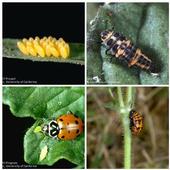![Green lacewing life cycle.[J.K. Clark]](https://ucanr.edu/blogs/UCIPMurbanpests/blogfiles/43911small.png)
Last week, we discussed some common beneficial predators that help control pests on garden and landscape plants. One such predator you might find, is a lacewing. In fact, you may have seen adult lacewings on or near porchlights in the evening, since these insects are attracted to lights.
Green Lacewings
Green lacewing (Chrysopa spp., Chrysoperla spp.) adults are green, soft-bodied insects with golden eyes and four membranous wings. Their larvae are pale with dark markings and a tapered tail, and measure 1/8 to 4/5 of an inch long.
There are several species of green lacewings; some species have predaceous adults, while others feed only on...

You're probably familiar with lady beetles (aka lady bugs), common beneficial insect predators that prey on aphids and other soft-bodied insects. However, lady beetles are not the only beneficial predators that can be found in your garden and landscape.
Other “natural enemies” such as assassin bugs, minute pirate bugs, lacewings, predatory wasps, spiders, and predaceous ground beetles attack and kill pests. In some cases, both the adults and larvae are predators. It's important to recognize the different life stages of these beneficial predators so you know they are helping control pests and not attacking your plants.
Protect beneficials...
![Catchweed bedstraw. [K. Windbiel-Rojas]](https://ucanr.edu/blogs/UCIPMurbanpests/blogfiles/42858small.jpg)
Catchweed bedstraw. It's that weed that tugs at your clothes while you pass by or attaches to your dog or cat's fur. It's also known as the “Velcro plant” since it easily clings to anything that touches it.
In the garden, catchweed bedstraw competes with landscape plants for nutrients, water and light. Once mature, it can reach 6 feet long and be problematic when it smothers desirable plants. It can also make it difficult for gardeners to harvest produce.
Catchweed bedstraw is a winter or summer annual in California. The best control is to physically remove it as soon as it appears so it does not spread. For tips on how to manage this weed in your landscape, please visit the
![Crimson fountaingrass. [J.M. DiTomaso]](https://ucanr.edu/blogs/UCIPMurbanpests/blogfiles/41883small.jpg)
Invasive plants are weeds that infest natural ecosystems, rangelands and pasture. They can cause dramatic ecological changes that affect both plant and animal communities. Once established, invasive plants are difficult to eradicate.
In California, exotic plants were originally introduced by humans who planned to use them for ornamental or aquarium use, or for use as forage, food, fiber, medicinal or soil stabilization purposes. In some cases, the unintended outcome has been plants that have become invasive.
Some invasive plants are still for sale at retail nursery and garden centers. Some examples of available invasive plant species include pampasgrass (
- Author: Anne Schellman
- Author: Karey Windbiel-Rojas
![Pruning out an scale insect infestation. [Photo by C. Reynolds]](https://ucanr.edu/blogs/UCIPMurbanpests/blogfiles/40504small.jpg)
Now is the time to prepare your garden and landscape for winter. The simple tasks recommended below will help prevent perennial weeds, insect pests, and certain disease pathogens so these problems don't get established and become difficult later.
Weeds
- Manage weeds using nonchemical methods such as cultivation, handweeding, or mowing.
- Prevent weeds using competitive plants, mulches, and hand removal.
- Herbicides (weed killers) are rarely needed in established landscape plantings when nonchemical controls are used regularly.
To learn more about managing weeds, see the UC IPM Pest Note: Weed...


